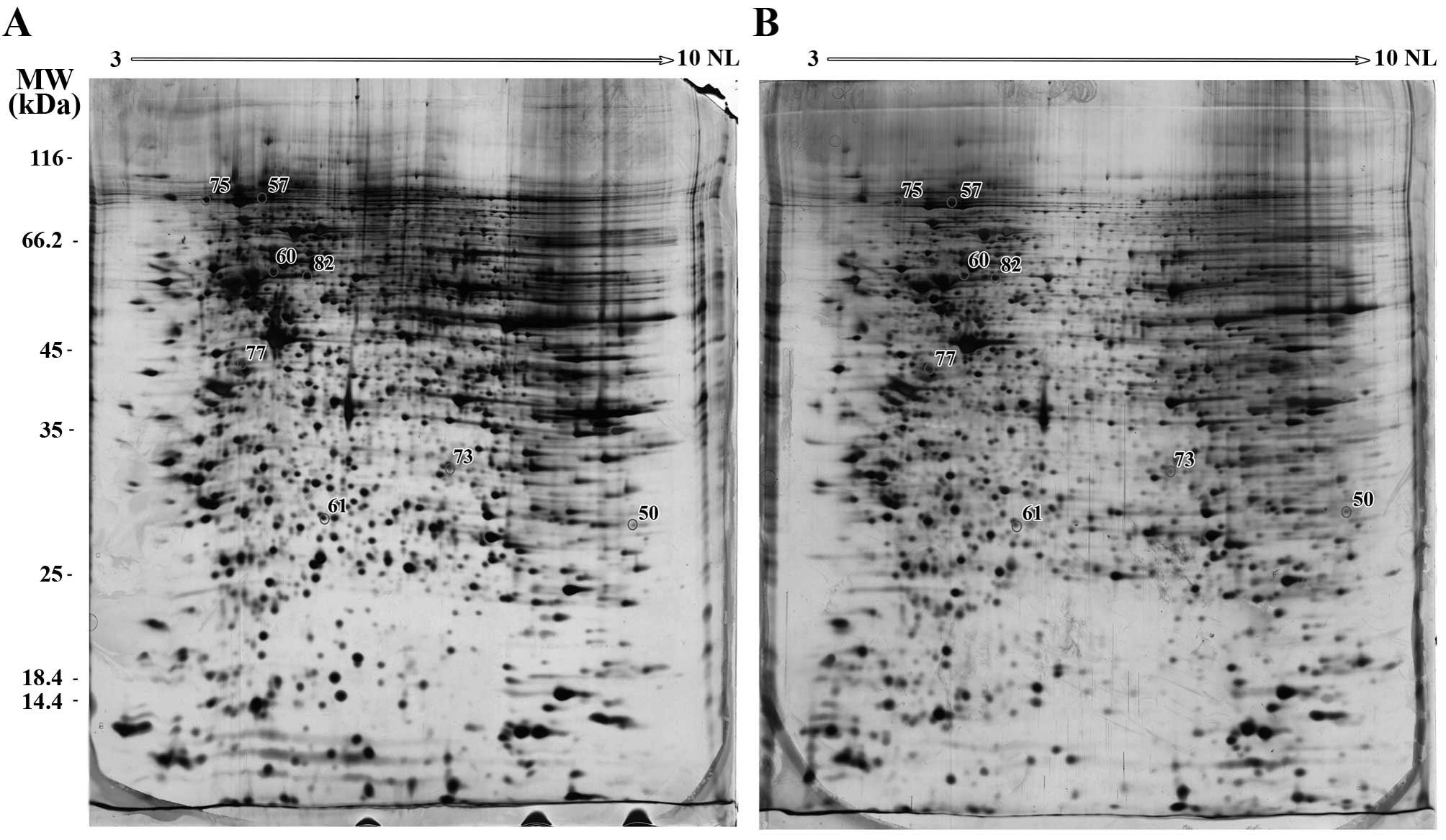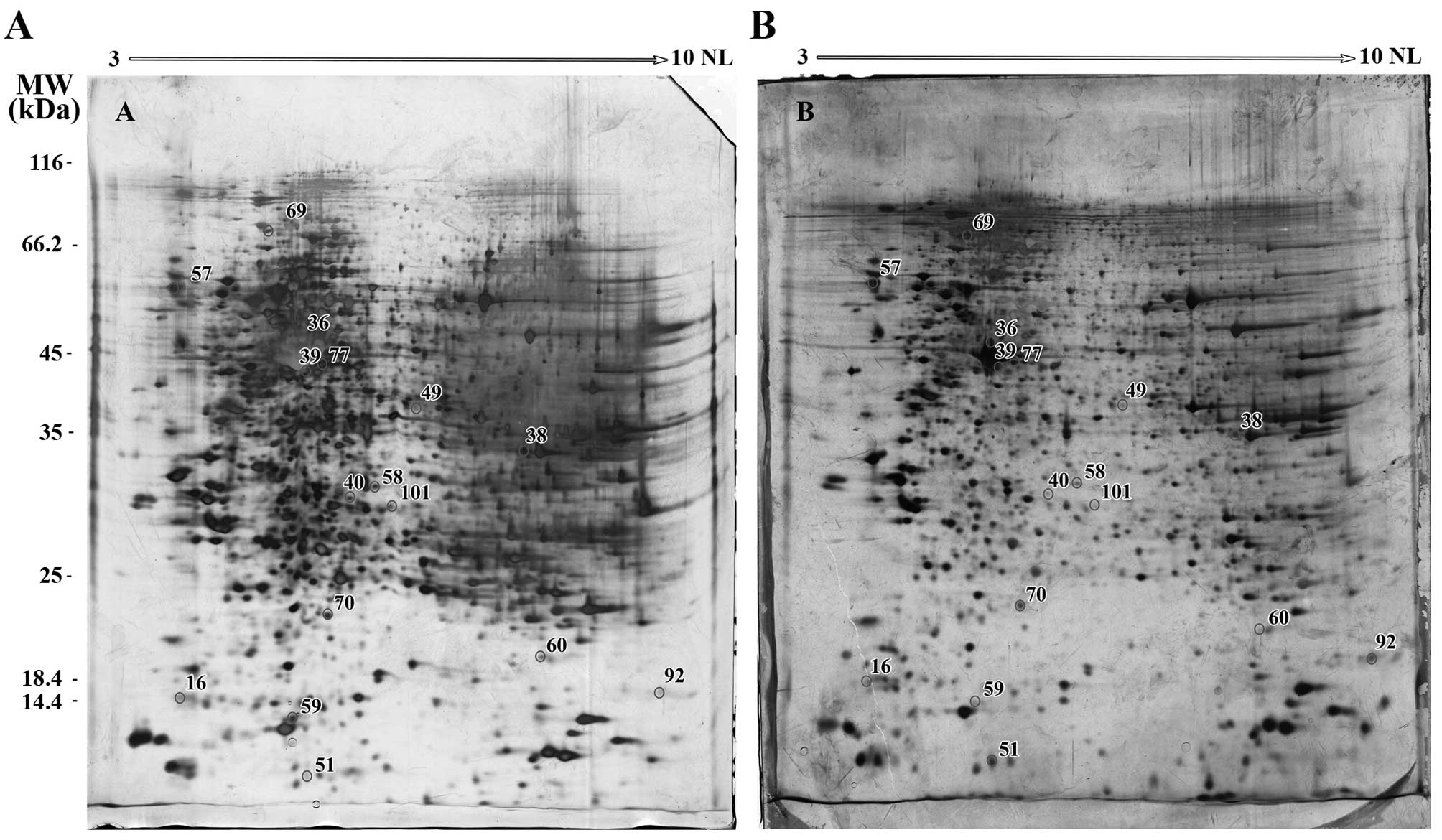|
1
|
Lacy A and O'Kennedy R: Studies on
coumarins and coumarin-related compounds to determine their
therapeutic role in the treatment of cancer. Curr Pharm Des.
10:3797–3811. 2004. View Article : Google Scholar : PubMed/NCBI
|
|
2
|
Khaghanzadeh N, Mojtahedi Z, Ramezani M,
Erfani N and Ghaderi A: Umbelliprenin is cytotoxic against QU-DB
large cell lung cancer cell line but anti-proliferative against
A549 adenocarcinoma cells. DARU. 20:692012. View Article : Google Scholar : PubMed/NCBI
|
|
3
|
Iranshahi M, Askari M, Sahebkar A and
Hadjipavlou-Litina D: Evaluation of antioxidant, anti-inflammatory
and lipoxygenase inhibitory activities of the prenylated coumarin
umbelliprenin. DARU. 17:99–103. 2009.
|
|
4
|
Soltani F, Mosaffa F, Iranshahi M, Karimi
G, Malekaneh M, Haghighi F and Behravan J: Auraptene from Ferula
szowitsiana protects human peripheral lymphocytes against oxidative
stress. Phytother Res. 24:85–89. 2010. View
Article : Google Scholar : PubMed/NCBI
|
|
5
|
Shahverdi AR, Saadat F, Khorramizadeh MR,
Iranshahi M and Khoshayand MR: Two matrix metalloproteinases
inhibitors from Ferula persica var. persica. Phytomedicine.
13:712–717. 2006. View Article : Google Scholar : PubMed/NCBI
|
|
6
|
Soltani F, Mosaffa F, Iranshahi M, Karimi
G, Malekaneh M, Haghighi F and Behravan J: Evaluation of
antigenotoxicity effects of umbelliprenin on human peripheral
lymphocytes exposed to oxidative stress. Cell Biol Toxicol.
25:291–296. 2009. View Article : Google Scholar : PubMed/NCBI
|
|
7
|
Khaghanzadeh N, Samiei A, Ramezani M,
Mojtahedi Z, Hosseinzadeh M and Ghaderi A: Umbelliprenin induced
production of IFN-γ and TNF-α, and reduced IL-10, IL-4, Foxp3 and
TGF-β in a mouse model of lung cancer. Immunopharmacol
Immunotoxicol. 36:25–32. 2014. View Article : Google Scholar : PubMed/NCBI
|
|
8
|
Iranshahi M, Sahebkar A, Takasaki M,
Konoshima T and Tokuda H: Cancer chemopreventive activity of the
prenylated coumarin, umbelliprenin, in vivo. Eur J Cancer Prev.
18:412–415. 2009. View Article : Google Scholar : PubMed/NCBI
|
|
9
|
Barthomeuf C, Lim S, Iranshahi M and
Chollet P: Umbelliprenin from Ferula szowitsiana inhibits the
growth of human M4Beu metastatic pigmented malignant melanoma cells
through cell-cycle arrest in G1 and induction of caspase-dependent
apoptosis. Phytomedicine. 15:103–111. 2008. View Article : Google Scholar : PubMed/NCBI
|
|
10
|
Blanchon F, Grivaux M, Asselain B, Lebas
FX, Orlando JP, Piquet J and Zureik M: 4-year mortality in patients
with non-small-cell lung cancer: Development and validation of a
prognostic index. Lancet Oncol. 7:829–836. 2006. View Article : Google Scholar : PubMed/NCBI
|
|
11
|
Hamidinia M, Ramezani M and Mojtahedi Z:
Cytotoxic/proliferative effects of umbelliprenin on colon cancer
cell lines. Ann Colorectal Res. 1:101–105. 2013. View Article : Google Scholar
|
|
12
|
Cai XZ, Huang WY, Qiao Y, Du SY, Chen Y,
Chen D, Yu S, Che RC, Liu N and Jiang Y: Inhibitory effects of
curcumin on gastric cancer cells: A proteomic study of molecular
targets. Phytomedicine. 20:495–505. 2013. View Article : Google Scholar : PubMed/NCBI
|
|
13
|
Askari M, Sahebkar A and Iranshahi M:
Synthesis and purification of 7-prenyloxycoumarins and herniarin as
bioactivenatural coumarins. Iran J Basic Med Sci. 12:63–69.
2009.
|
|
14
|
Mojtahedi Z, Safaei A, Yousefi Z and
Ghaderi A: Immunoproteomics of HER2-positive and HER2-negative
breast cancer patients with positive lymph nodes. OMICS.
15:409–418. 2011. View Article : Google Scholar : PubMed/NCBI
|
|
15
|
Okutucu B, Dinçer A, Habib O and Zihnioglu
F: Comparison of five methods for determination of total plasma
protein concentration. J Biochem Biophys Methods. 70:709–711. 2007.
View Article : Google Scholar : PubMed/NCBI
|
|
16
|
Sarvari J, Mojtahedi Z, Kuramitsu Y,
Malek-Hosseini SA, Shahrabadi M Shamsi, Ghaderi A and Nakamura K:
Differential expression of haptoglobin isoforms in chronic active
hepatitis, cirrhosis and HCC related to HBV infection. Oncol Lett.
2:871–877. 2011.PubMed/NCBI
|
|
17
|
Wang Q, An L, Chen Y and Yue S: Expression
of endoplasmic reticulum molecular chaperon GRP94 in human lung
cancer tissues and its clinical significance. Chin Med J (Engl).
115:1615–1619. 2002.PubMed/NCBI
|
|
18
|
Alarcon SV, Mollapour M, Lee MJ, Tsutsumi
S, Lee S, Kim YS, Prince T, Apolo AB, Giaccone G, Xu W, et al:
Tumor-intrinsic and tumor-extrinsic factors impacting hsp90-
targeted therapy. Curr Mol Med. 12:1125–1141. 2012. View Article : Google Scholar : PubMed/NCBI
|
|
19
|
Byun Y, Chen F, Chang R, Trivedi M, Green
KJ and Cryns VL: Caspase cleavage of vimentin disrupts intermediate
filaments and promotes apoptosis. Cell Death Differ. 8:443–450.
2001. View Article : Google Scholar : PubMed/NCBI
|
|
20
|
Satelli A and Li S: Vimentin in cancer and
its potential as a molecular target in cancer therapy. Cell Mol
Life Sci. 68:3033–3046. 2011. View Article : Google Scholar : PubMed/NCBI
|
|
21
|
Cheng CW, Kuo CY, Fan CC, Fang WC, Jiang
SS, Lo YK, Wang TY, Kao MC and Lee AY: Overexpression of Lon
contributes to survival and aggressive phenotype of cancer cells
through mitochondrial complex I-mediated generation of reactive
oxygen species. Cell Death Dis. 4:e6812013. View Article : Google Scholar : PubMed/NCBI
|
|
22
|
Magnaghi P, D'Alessio R, Valsasina B,
Avanzi N, Rizzi S, Asa D, Gasparri F, Cozzi L, Cucchi U, Orrenius
C, et al: Covalent and allosteric inhibitors of the ATPase VCP/p97
induce cancer cell death. Nat Chem Biol. 9:548–556. 2013.
View Article : Google Scholar : PubMed/NCBI
|
|
23
|
Christiansen A and Dyrskjøt L: The
functional role of the novel biomarker karyopherin α 2 (KPNA2) in
cancer. Cancer Lett. 331:18–23. 2013. View Article : Google Scholar : PubMed/NCBI
|
|
24
|
Kim SN, Kim NH, Park YS, Kim H, Lee S,
Wang Q and Kim YK: 7-Diethylamino-3(2′-benzoxazolyl)-coumarin is a
novel microtubule inhibitor with antimitotic activity in multidrug
resistant cancer cells. Biochem Pharmacol. 77:1773–1779. 2009.
View Article : Google Scholar : PubMed/NCBI
|
|
25
|
Lawrenson K, Mhawech-Fauceglia P,
Worthington J, Spindler TJ, O'Brien D, Lee JM, Spain G, Sharifian
M, Wang G, Darcy KM, et al: Identification of novel candidate
biomarkers of epithelial ovarian cancer by profiling the secretomes
of three-dimensional genetic models of ovarian carcinogenesis. Int
J Cancer. 137:1806–1817. 2015. View Article : Google Scholar : PubMed/NCBI
|
|
26
|
Kim Y, Jang M, Lim S, Won H, Yoon KS, Park
JH, Kim HJ, Kim BH, Park WS, Ha J and Kim SS: Role of cyclophilin B
in tumorigenesis and cisplatin resistance in hepatocellular
carcinoma in humans. Hepatology. 54:1661–1678. 2011. View Article : Google Scholar : PubMed/NCBI
|
|
27
|
Kamal MA and Christopherson RI:
Accumulation of 5-phosphoribosyl-1-pyrophosphate in human CCRF-CEM
leukaemia cells treated with antifolates. Int J Biochem Cell Biol.
36:545–551. 2004. View Article : Google Scholar : PubMed/NCBI
|
|
28
|
Burke AJ, Sullivan FJ, Giles FJ and Glynn
SA: The Yin and Yang of nitric oxide in cancer progression.
Carcinogenesis. 34:503–512. 2013. View Article : Google Scholar : PubMed/NCBI
|
|
29
|
Arnoldussen YJ, Lorenzo PI, Pretorius ME,
Waehre H, Risberg B, Maelandsmo GM, Danielsen HE and Saatcioglu F:
The mitogen-activated protein kinase phosphatase vaccinia
H1-related protein inhibits apoptosis in prostate cancer cells and
is overexpressed in prostate cancer. Cancer Res. 68:9255–9264.
2008. View Article : Google Scholar : PubMed/NCBI
|
|
30
|
Rawat SJ and Chernoff J: Regulation of
mammalian Ste20 (Mst) kinases. Trends Biochem Sci. 40:149–156.
2015. View Article : Google Scholar : PubMed/NCBI
|
|
31
|
Malhotra A, Shibata Y, Hall IM and Dutta
A: Chromosomal structural variations during progression of a
prostate epithelial cell line to a malignant metastatic state
inactivate the NF2, NIPSNAP1, UGT2B17, and LPIN2 genes. Cancer Biol
Ther. 14:840–852. 2013. View Article : Google Scholar : PubMed/NCBI
|
|
32
|
Park MC, Kang T, Jin D, Han JM, Kim SB,
Park YJ, Cho K, Park YW, Guo M, He W, et al: Secreted human
glycyl-tRNA synthetase implicated in defense against ERK-activated
tumorigenesis. Proc Natl Acad Sci USA. 109:E640–E647. 2012.
View Article : Google Scholar : PubMed/NCBI
|
|
33
|
Fernandez PM, Tabbara SO, Jacobs LK,
Manning FC, Tsangaris TN, Schwartz AM, Kennedy KA and Patierno SR:
Overexpression of the glucose-regulated stress gene GRP78 in
malignant but not benign human breast lesions. Breast Cancer Res
Treat. 59:15–26. 2000. View Article : Google Scholar : PubMed/NCBI
|
|
34
|
Horie M, Saito A, Mikami Y, Ohshima M,
Morishita Y, Nakajima J, Kohyama T and Nagase T: Characterization
of human lung cancer-associated fibroblasts in three-dimensional in
vitro co-culture model. Biochem Biophys Res Commun. 423:158–163.
2012. View Article : Google Scholar : PubMed/NCBI
|
|
35
|
Yousefi Z, Sarvari J, Nakamura K,
Kuramitsu Y, Ghaderi A and Mojtahedi Z: Secretomic analysis of
large cell lung cancer cell lines using two-dimensional gel
electrophoresis coupled to mass spectrometry. Folia Histochem
Cytobiol. 50:368–874. 2012. View Article : Google Scholar : PubMed/NCBI
|
|
36
|
Korbelik M, Zhang W and Merchant S:
Involvement of damage-associated molecular patterns in tumor
response to photodynamic therapy: Surface expression of
calreticulin and high-mobility group box-1 release. Cancer Immunol
Immunother. 60:1431–1437. 2011. View Article : Google Scholar : PubMed/NCBI
|
|
37
|
Liu R, Gong J, Chen J, Li Q, Song C, Zhang
J, Li Y, Liu Z, Dong Y, Chen L and Jin B: Calreticulin as a
potential diagnostic biomarker for lung cancer. Cancer Immunol
Immunother. 61:855–864. 2012. View Article : Google Scholar : PubMed/NCBI
|
















